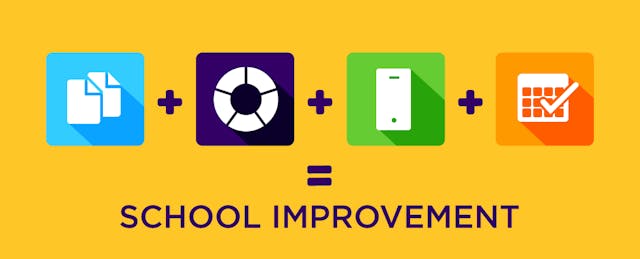We’ve all heard the stories: A school goes from takeover to high performing in a single year. A district launches an innovative new program, and graduation rates skyrocket.
But the reality for many schools is quite different. Despite the incredible work they do, nothing seems to move the needle—and they never quite reach their goals.
Why is it that some schools succeed, while others struggle so much?
The answer is simple: School improvement isn’t magic, it’s a science—a matter of taking the proper steps that lead to sustained success time and again.
First, schools need to establish a strategic plan for fulfilling their goals. Then, they need an educator effectiveness process to fulfill that plan, followed by technology to support it and a commitment to long-term implementation.
When K-12 leaders follow these four critical steps, almost everything about their schools can improve.
How do we know this? Because for years at School Improvement Network, we’ve helped our partners take these same steps, and their successes have become the subject of more than a dozen studies published in peer-reviewed journals.
Let’s look at how research supports these four keys to successful school improvement.
A plan
When it comes to school improvement, there’s nothing more important than having a strategic plan.
One study measured the results among educators that used Edivate, our on-demand professional learning resource that creates a highly personalized learning experience for educators. It found that schools with an established strategic plan for driving Edivate usage achieved significant gains—more than four times the gains in reading and 10 times the gains in math over neighboring schools without a plan.
The lesson is clear: When schools have a strategic plan in place, teacher buy-in and engagement go up, resulting in significant gains in student achievement.
A process
But a strategic plan on its own will only get you so far. You also need to establish an educator effectiveness process to fulfill that plan.
In a study published in the Journal of College Teaching & Learning, researchers found that when schools established a clear process to increase educator effectiveness, they experienced significant gains in student achievement.
The schools that were examined implemented a process of regular classroom observations, followed up by targeted professional development.
The results were remarkable. After just a year of implementing this process, these schools enjoyed a nearly 25-percent better average gain in student proficiency on standardized math and reading test scores as compared to neighboring schools.
Technology to support these
But research suggests that just as important as establishing a strategic plan and an educator effectiveness process is investing in the right technology to support school improvement efforts: technology that aligns to, scales, and supports your strategic plan and process.
A study published in the International Journal of Evaluation and Research in Education examined the difference between schools that used Edivate—an online platform can be easily adapted to support any strategic plan and process—and those that used other forms of professional learning. The difference was substantial.
Schools that used Edivate saw an average increase of 18.5 percent in student proficiency on standardized assessments in just one year. Schools without Edivate had a much harder time improving student achievement, only increasing their growth rate by 3.5 percent during the same period.
Implementation and follow-through
And finally, even with everything else in place, successful school improvement is only possible with a strong commitment to long-term implementation of the strategic plan.
This can be challenging, but as the research shows, it’s well worth it.
A study published in the Journal of International Education Research tracked the gains in student achievement over time in schools that used Edivate. The results revealed that schools with consistent implementation were not only more successful in the long run, but their rate of student achievement gain increased over time.
A strategic plan, an educator effectiveness process, the right technology, and long-term implementation: Together, they make up research-proven steps for successful school improvement.
It’s an approach built upon years of research and validated in more than 20,000 schools and districts worldwide.
To get advice and strategies for successfully implementing these four keys in your school or district, please download our free white paper, “Four Keys to Successful School Improvement.”



